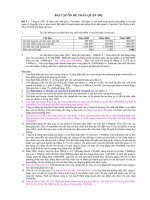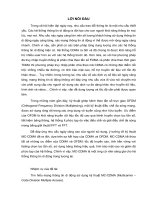wamenhubindonesiatransportation 130108083153 phpapp01 (1)
Bạn đang xem bản rút gọn của tài liệu. Xem và tải ngay bản đầy đủ của tài liệu tại đây (6.92 MB, 58 trang )
INDONESIA TRANSPORTATION SECTOR OVERVIEW
Infrastructure Forum 4 December 2012
Den Haag
Bambang Susantono, Ph.D.
Vice Minister for Ministry of Transportation
Republic of Indonesia
Snapshots of the country
2
Indonesia Today and in 2030
16th largest economy in the world
9th largest economy in the world
45 million members of the
135 million members of the
53% population in cities producing
74% of GDP
71% population in cities producing
86% of GDP
55 million skilled workers
113 million skilled workers needed
$ 0.5 trillion market
$ 1.8 trillion market opportunity
consuming class
opportunity in consumer services,
agriculture and fisheries, resources
and education
consuming class
in consumer services, agriculture and
fisheries, resources and education
Source: McKinsey Global Institute
33
GDP and urbanization pattern in the future
86 % GDP
comes
from
Urban
Areas and
63% from
midsize
cities
4
Indonesia GDP growth 2010 - 2030
5
More than just population size ...
6
The World Embrace Indonesia Performance
7
Indonesia to be the 4th largest economy in 2050
World’s 10 largest economies, 2010 (USD Tn, PPP)
World’s 10 largest economies, 2050 (USD Tn, PPP)
2012 – World’s 15th
(USD 1,12 Tn, PPP)
8
Breakthrough of MP3EI
Master Plan Acceleration and Expansion of Indonesia Economic Development (MP3EI) is
intended to accelerate and foster economic development across the nation through 6 (six)
economic development corridors. This master plan implements the spirit of “not business as
usual”.
Source: MP3EI, 2011
9
MP3EI
Vision
.... THE ECONOMIC MASTERPLAN
MAIN STRATEGY
ECONOMIC CORRIDORS DEVELOPMENT
STRENGTHENING THE NATIONAL CONNECTIVITY
STRENGTHENING HR CAPABILITY AND SCI - TECH
10
Currently, indicated MP3EI investments are ~ Rp. 4,930 T (USD 500 billion)
including ~ Rp. 2,373 T (USD 250 billion) for infrastructure development
Indicated MP3EI investment (Rp T)*
Indicated Infrastructure investment (Rp T)*
4.930
2.373
604
416
201
208
78
156
205
1.109
1.156
1.460
577
1.133
Sumatera Jawa Kalimantan
Bali Sulawesi NT
Papua Total
Maluku
Sumatera Jawa Kalimantan
Bali Sulawesi NT
Papua Total
Maluku
* As of April 2012
11
11
Implementation So Far (After 1 Year)
In billion
USD
Planned
Realization
Real Sector
Infrastructure
27.8
251
18.8
170
46.7
58 projects
56 projects
114 projects
21.6
194
49 projects
18
162
50 projects
39.6
99 projects
In billion
USD
Real Sector
33.9
305
Planned
(Up to July 2012)
Realization
16 projects
89
9.8
51
5.7
Infrastructure
7.2
65
41.1
39
55 projects
projects
15.5
36 projects
9
27
projects projects
12
Indonesia offers huge investment opportunity:
Palm Oil Industry
Sei Mangke (Medan,
North Sumatera)
13
Sei Mangkei Special Economic Zone (SEZ) provide various
opportunities for investment
Regulated under the Government Law No 29/2012
Several advantage of Sei Mangkei SEZ
1.
There are three phase of development in Sei
Mangkei SEZ:
1.
2.
3.
Develop 104 Ha Area
Expand to 640 Ha; (principal permit already issued,
currently waiting for the Right to Build permit)
Developing its area to total 2002,77 Ha
There are three investor already commited:
1.
2.
3.
PT Sinergi Oleo Nusantara (USD 415 Million on
biodiesel – bCarotene integrated – industry)
PT Cipta Buana Utama Mandiri (Rp 0,4 T on fertilizer
industry)
PT Unilever Indonesia (Rp 1,2 T on oleochemicals
industry)
2.
3.
4.
5.
40 km to the Kuala Tanjung Port . Under the
MP3EI program, this port will be developed to a
global hub port.
Nearby the “Gunung Bayu – Petlanaan Station”
railway track
Already produced 30 Ton / hour of Fresh Fruit
Bunches (FFB) since 1997
Abundance in water supply. Water are supplied
from the Bah Bolon Rover( water debit 37,3
m3/second)
Nearby to several Large Palm Oil Plantations
(70 km radius):
1. PTPN III = 165 Ton FFB/hour
2. PTPN IV = ± 300 Ton FFB/hour
3. Private = ± 104 Ton FFB / hour
14
Sei Mangkei SEZ will be supported by infrastructure
development
There 18 infrastructure projects related with MP3EI
which will support Sei Mangkei SEZ ...
Railway Plan
Rp Billion
Road and
Seaport Railway Bridge Energy Energy
5,644
2
projects
Total
699
4
projects
Examples:
Road Plan
4,148
91
10
projects
1
project
39
1
project
10,621
18
projects
15
15
Transport Infrastructure Investment Needs in
Economic Corridors
Sumatera EC
(USD 9,279 Million):
Kalimantan EC
(USD 5,366 Million):
• Railway: USD 7,826 Million
• Port: USD 1,006 Million
• Airport: USD 447 Million
Sumatera
Economic
Corridor
• Railway: USD 3,913 Million
• Port: USD 1,118 Million
• Airport: USD 335 Million
Kalimantan
Economic
Corridor
Sulawesi EC
(USD 671 Million):
• Port: USD 671 Million
Sulawesi
Economic
Corridor
Papua – Kep.
Maluku Economic
Corridor
Java Economic
Corridor
Bali Nusa Tenggara
Economic Corridor
Java EC
(USD 18,558 Million):
• Railway: USD.11,738 Million
• Port: USD 5,031 Million
• Airport: USD 1,789 Million
Source : MP3EI, 2011
Bali - Nusa Tenggara EC
(USD 1,677 Million):
• Railway: USD 1,342 Million
• Airport: USD 335 Million
Papua-Kep. Maluku EC
(USD 6,618 Million) :
• Port: USD 6,596 Million
• Airport: USD 22 Million
16
Acceleration of Transport Infrastructure Development
Non -Cost
Recovery
Project
MP3EI
Transport Infrastructure
•State Budget
•Local Budget
Tender / Right To
Match
Public
PPP
No
Infrastructure
1
Ports and Inland
Waterways
2
3
Investment
Need (USD
Million)
Est. # of
Projects
13,080
92
Airports
3,577
14
Railways
36,445
25
Total
53,102
131
Infrastructure
Cost
Recovery
Project
SOE Special
Asssignment
Private
Infrastructure
(Private Purpose)
•Law 23/2007 on Railway
•Law 17/2008 on Shipping
•Law1/2009 on Aviation
•GR 67/05
•GR 13/10
•GR 56/11
Presidential
Regulation on
SOE Special
Assignment
Licencing
•Special Airports
•Special Ports, Special Terminals
•Special Railways
17
Private Sector Involvement Is Made Possible through
Regulatory Reform in Transport Sector
Previous Regulations
New Regulations
• Overlapping roles of regulator,
operator and contracting
agency
• Clear separation of role between
regulator, operator & contracting
agency
• Monopolistic / Single Provider
• Multi-operator
• Limited access for Private
Sector
• Wider access for the involvement of
Private Sector
• Centralized
• Decentralized
• More on supply approach
• Combination of accessibility and
market-driven approaches
• Minimum access for the
Government Support
• Wider access for the Government
Support
18
Three Ways of Private Sectors Involvement in
Transport Infrastructure Development
Investments in
Transport Sector
Special Purpose Transport
Infrastructure
• Infrastructure specially developed for the
purpose of a business entity and may
operate exclusively for the business
entity.
• Usually unsolicited, i.e. initially proposed
by the business entity (private sector)
• Ministry of Transportation reviews the
feasibility study and other technical
matters, including safety issues
• The investment procedure for the special
purpose transport is done through the
LICENCING (business licence, location
licence, construction licence, and
operation licence).
SEZ/FTZ Transport
Infrastructure
Public / Commercial
Transport Infrastructure
• Infrastructure is located in the
Special Economic Zones (SEZ)
or in Free Trade Zones (FTZ)
• Infrastructure to be used by
public and commercially
oriented (tariff applied)
• Several incentives such as
reduced tax rates
• May be solicited (proposed
by the GoI) or unsolicited
• More relaxed restrictions
(compared to the Negative
Investment List)
• More incentives and exceptions
for the projects in the Bounded
Zones (Kawasan Berikat)
• The investment procedure is
through simplified integrated
LICENCING from the FTZ/SEZ
administrators
• Ministry of Transport prepares
the project documents and
tender documents, including
feasibility study
• The business entity is chosen
through TENDER (in
accordance to Presidential
Regulation No. 56/2011)
19
Government had provided many endorsements and incentives in
order to attract private invesments
Several government supports and incentives are in
place to attract more investors ......
... Whilst the government is working to prepare the potential
infrastructure projects to be offered to the private sectors.
Geothermal Fund: reducing the investor risks
during exploration activities
Tax Holiday
Facility
Presidential Regulation no. 71/2012:
providing clear mechanism and duration of
every stages in land acquisition process
PPP Scheme
and
Regulation
Land
Procurement
Regulations
Viability Gap
Fund
Government
supports and
incentives
Geothermal
Fund
Viability Gap Fund: government support to
increase the financial feasibility for
infrastructure projects. Some infrastructure
sector may have this facility such as toll road,
water sector, etc
Land Capping: government support to reduce
the risk due to the unpredicted and unavoidable
increasing land price
20
20
Recent amendment on Presidential Decree No. 67/2005
(Presidential Decrees No. 56/2011), had eased PPP from
straining regulations
There are several changes that have been
made through PD No. 56 / 2011 ...
Permits unsolicited proposal
Easier tender process
Allows Ministry of Finance to give
guarantees through appointed
institutions
Allows SOE’s to become the
contracting agencies
... simultaneously supported with
government programs
Project Development Facility: to fund
feasibility studies. given as revolving
fund to be repaid by winning bidder
Land Capping: To cover the risk of
increasing cost of land acquisition
above certain level.
Land Revolving Fund: Provide
bridging finance for land acquisition
Guarantee Fund: provides guarantee
for risks better covered by government
Viability Gap Fund: provides financial
support in the form of grants, one tie or
deferred, to make them commercially
viable
21
Government have been vigorously providing support in every
step of PPP process
Fiscal support given along PPP process
Preparation
(Project Development
Facility)
Objective
Providing
Party
Bidding
Land Fund
Government
Guarantee
Implementation
Infrastructure Fund
Project Development
Facility (PDF) will be used
by CAs to fund feasibility
studies, and is essential to
ensure initiation and
implementation of projects
– PDF given as
revolving fund to be
repaid by winning
bidder
Two types of Land Fund:
• Land Revolving Fund:
Provide bridging finance
for land acquisition
• Land Capping: Cover risk
of increasing cost of land
Guarantee fund provides
guarantee for risks better
covered by government
• e.g. political, price,
land acquisition delay
• Based on Perpres 78 /
2010 and Permenkeu
260/PMK.011/2010
• Takes part in financing a
commercially viable
project
– Can be as debt, equity
or credit
enhancement
guarantees
PT SMI (PT Sarana
Multistruktur Indonesia)
Managed by Government
Investment Unit (under Min.
Finance) and forwarded
through Toll Road
Regulatory Agency (under
Min. Public Works)
PT PII (PT Penjaminan
Infrastruktur Indonesia)
PT IIF (Indonesia
Infrastructure Fund), a
subsidiary under PT SMI
PT IIF
22
22
TRANSPORTATION SECTOR INVESTMENT CLIMATE
23
Opportunities in Air Transport Sector
Airline penetration levels
• With a population of more than 240
million, and with major airports
handling more than 68 million
passengers in 2011, Indonesia
presents itself as an immense
aviation opportunity as one of the
fastest growing domestic air traffic
markets in the world.
• Domestic air passengers grew on
average 12.1% per year from 2006 to
2011, while international air
passengers grew 22.4% annually
within the same period.
Population
(m)
232
240
87
92
28
67
5
496
Source: Euromonitor
Indonesian Airports – Annual Domestic & International
Passengers 2006 to 2011
• ASEAN Open Skies in 2015 will
further increase the demand of air
travels
Source: DGCA, 2011
24
Emerging economies drive strong travel growth
• Worlds air transport double every 15 years and will double again in the next
15 years
• Indonesian air transport is forecast to double within 10 years
Source: Airbus, 2012
25









